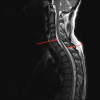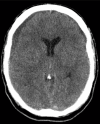When does too little pressure become too much? A case of spontaneous intracranial hypotension presenting with acute loss of consciousness
- PMID: 37810301
- PMCID: PMC10559507
- DOI: 10.25259/SNI_293_2023
When does too little pressure become too much? A case of spontaneous intracranial hypotension presenting with acute loss of consciousness
Abstract
Background: We present a unique case of spontaneous intracranial hypotension (SIH) presenting with acute collapse and loss of consciousness.
Case description: The affected patient suffered an abrupt decline in level of consciousness several weeks after initial diagnosis. The patient was urgently transferred to a specialist neurosurgical unit. Imaging showed bilateral subdural fluid collections with significant associated local mass effect. The treating team faced a clinical conundrum with a lack of clarity as to whether this sudden deterioration was secondary to the local pressure effect on brainstem traction from reduced intracranial pressure. A decision was made to proceed with urgent burr-hole decompression of the bilateral subdural fluid collections.
Conclusion: After a protracted, complex postoperative course, the patient recovered to full functional independence. To the author's knowledge, this is the first case in literature describing successful surgical management of SIH, with bilateral burr-hole evacuation to relieve the paradoxical mass effect of bilateral subdural fluid collections.
Keywords: Cerebrospinal fluid effusion; Essential intracranial hypotension; Neurosurgery; Spontaneous subdural surgical management.
Copyright: © 2023 Surgical Neurology International.
Conflict of interest statement
There are no conflicts of interest.
Figures






References
-
- Chen YC, Wang YF, Li JY, Chen SP, Lirng JF, Hseu SS, et al. Treatment and prognosis of subdural hematoma in patients with spontaneous intracranial hypotension. Cephalalgia. 2016;36:225–31. - PubMed
-
- Ganau L, Prisco L, Ganau M. High altitude induced bilateral non-traumatic subdural hematoma. Aviat Space Environ Med. 2012;83:899–901. - PubMed
-
- Kwok JM, Mandell DM, Margolin EA. Papilledema in a patient with intracranial hypotension. J Neuroophthalmol. 2021;41:e708–10. - PubMed
Publication types
LinkOut - more resources
Full Text Sources
